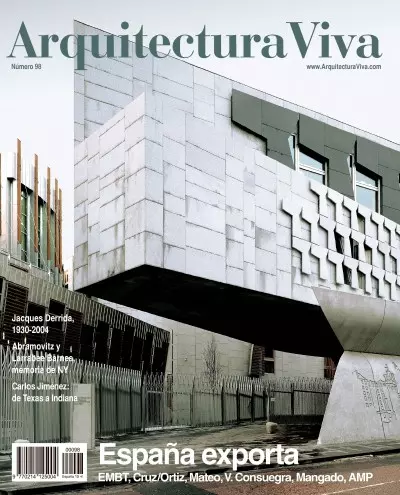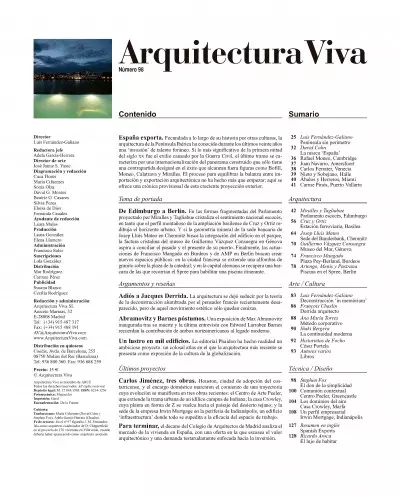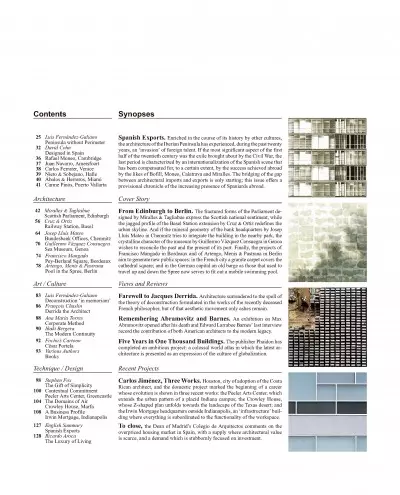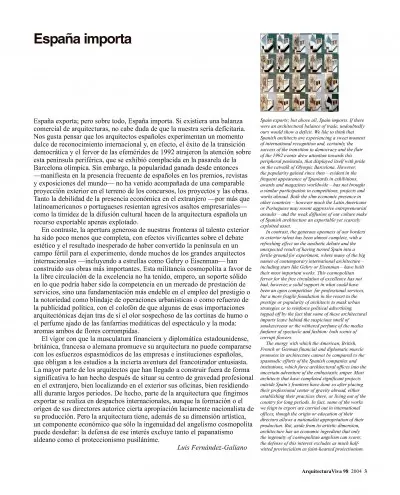Synopses
Spanish Exports. Enriched in the course of its history by other cultures, the architecture of the Iberian Peninsula has experienced, during the past twenty years, an ‘invasion’ of foreign talent. If the most significant aspect of the first half of the twentieth century was the exile brought about by the Civil War, the last period is characterized by an internationalization of the Spanish scene that has been compensated for, to a certain extent, by the success achieved abroad by the likes of Bofill, Moneo, Calatrava and Miralles. The bridging of the gap between architectural imports and exports is only starting; this issue offers a provisional chronicle of the increasing presence of Spaniards abroad.
Contents
Luis Fernández-Galiano
Peninsula without Perimeter
David Cohn
Designed in Spain
Rafael Moneo, Cambridge
Juan Navarro, Amersfoort
Carlos Ferrater, Venice
Nieto & Sobejano, Halle
Ábalos & Herreros, Miami
Carme Pinós, Puerto Vallarta
Cover Story
From Edinburgh to Berlin. The fractured forms of the Parliament designed by Miralles & Tagliabue express the Scottish national sentiment, while the jagged profile of the Basel Station extension by Cruz & Ortiz redefines the urban skyline. And if the mineral geometry of the bank headquarters by Josep Lluís Mateo in Chemnitz tries to integrate the building in the nearby park, the crystalline character of the museum by Guillermo Vázquez Consuegra in Genoa wishes to reconcile the past and the present of its port. Finally, the projects of Francisco Mangado in Bordeaux and of Artengo, Menis & Pastrana in Berlin aim to generate new public spaces: in the French city a granite carpet covers the cathedral square; and in the German capital an old barge as those that used to travel up and down the Spree now serves to fit out a mobile swimming pool.
Architecture
Miralles & Tagliabue
Scottish Parliament, Edinburgh
Cruz & Ortiz
Railway Station, Basel
Josep Lluís Mateo
Bundesbank Offices, Chemnitz
Guillermo Vázquez Consuegra
Sea Museum, Genoa
Francisco Mangado
Pey-Berland Square, Bordeaux
Artengo, Menis & Pastrana
Pool in the Spree, Berlin
Views and Reviews
Farewell to Jacques Derrida. Architecture surrendered to the spell of the theory of deconstruction formulated in the works of the recently deceased French philosopher, but of that aesthetic movement only ashes remain.
Art / Culture
Luis Fernández-Galiano
Deconstruction ‘in memoriam’
François Chaslin
Derrida the Architect
Remembering Abramovitz and Barnes. An exhibition on Max Abramovitz opened after his death and Edward Larrabee Barnes’ last interview record the contribution of both American architects to the modern legacy.Ana María Torres
Corporate Method
Iñaki Bergera
The Modern ContinuityFive Years in One Thousand Buildings. The publisher Phaidon has completed an ambitious project: a colossal world atlas in which the latest architecture is presented as an expression of the culture of globalization.Focho’s Cartoon
César Portela
Various Authors
BooksRecent Projects
Carlos Jiménez, Three Works. Houston, city of adoption of the Costa Rican architect, and the domestic project marked the beginning of a career whose evolution is shown in three recent works: the Peeler Arts Center, which extends the urban pattern of a placid Indiana campus; the Crowley House, whose Z-shaped plan unfolds towards the landscape of the Texas desert; and the Irwin Mortgage headquarters outside Indianapolis, an ‘infrastructure’ building where everything is subordinated to the functionality of the workspace.
Technique / Style
Stephen Fox
The Gift of Simplicity
Contextual Commitment
Peeler Arts Center, Greencastle
The Domains of Air
Crowley House, Marfa
A Business Profile
Irwin Mortgage, Indianapolis
To close, the Dean of Madrid’s Colegio de Arquitectos comments on the overpriced housing market in Spain, with a supply where architectural value is scarce, and a demand which is stubbornly focused on investment.English Summary
Spanish Exports
Ricardo Aroca
The Luxury of Living
Luis Fernández-Galiano
Spain imports
Spain exports; but above all, Spain imports. If there were an architectural balance of trade, undoubtedly ours would show a deficit.We like to think that Spanish architects are experiencing a sweet moment of international recognition and, certainly, the success of the transition to democracy and the flair of the 1992 events drew attention towards this peripheral peninsula,that displayed itself with pride on the catwalk of Olympic Barcelona. However, the popularity gained since then – evident in the frequent appearance of Spaniards in exhibitions, awards and magazines worldwide – has not brought a similar participation in competitions, projects and works abroad. Both the slim economic presence in other countries – however much the Latin Americans or Portuguese may resent aggressive entrepreneurial assaults – and the weak diffusion of our culture make of Spanish architecture an exportable yet scarcely exploited asset.
In contrast, the generous openness of our borders to exterior talent has been almost complete, with a refreshing effect on the aesthetic debate and the unexpected result of having turned Spain into a fertile ground for experiment,where many of the big names of contemporary international architecture – including stars like Gehry or Eisenman – have built their most important works. This cosmopolitan fervor for the free circulation of excellence has not had, however, a solid support in what could have been an open competition for professional services, but a more fragile foundation in the resort to the prestige or popularity of architects to mask urban strategies or to reinforce political advertising, topped off by the fact that some of these architectural imports leave behind the suspicious smell of smokescreens or the withered perfume of the media fanfares of spectacle and fashion:both scents of corrupt flowers.
The energy with which the American, British, French or German financial and diplomatic muscle promotes its architecture cannot be compared to the spasmodic efforts of the Spanish companies and institutions, which force architectural offices into the uncertain adventure of the enthusiastic sniper. Most architects that have completed significant projects outside Spain ’s frontiers have done so after placing their professional center of gravity abroad, either establishing their practices there, or living out of the country for long periods.In fact,some of the works we feign to export are carried out in international offices, though the origin or education of their directors allows a nationalist appropriation of their production. But, aside from its artistic dimension, architecture has an economic ingredient that only the ingenuity of cosmopolitan angelism can scorn: the defense of this interest excludes as much half-witted provincialism as faint-hearted protectionism.








